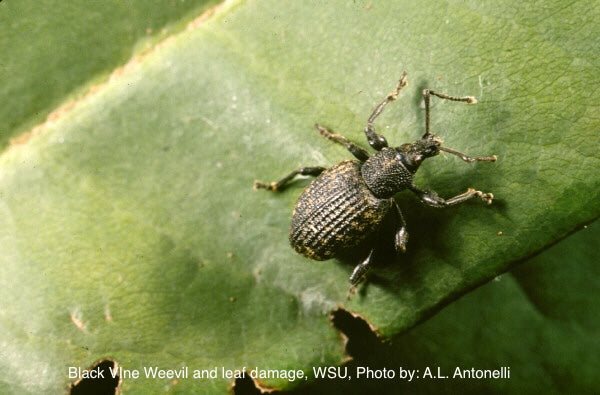Black Vine Weevil

Are you growing wine grapes, hops, Camellia or rhododendron and notice now, or last season, notching on leaf margins? Feeding damage of buds and flowers? It could be the insect pest, Black Vine Weevil (Otiorhynchus sulcatus) which is spread across the United States and feeds on over 200 plant species. Other susceptible plants include yew, hemlock, begonia, cyclamen, fuchsia, impatiens, primrose, epimedium, bergenia and sedum.
The white c-shaped larvae live underground, feeding on roots, while the dark colored adults sneak onto the plant at night to feed, returning to the soil and leaf litter to hide during the day. This nocturnal behavior makes them difficult to control once established. They also lack natural predators, and the females reproduce parthenogenically, so populations can grow very quickly if not checked. Prevention should be the goal for management.
BVW overwinter in pupal cases in the soil until the adults emerge in late May to early July. They feed on plant material for around a month before they begin laying eggs. The females then deposit several eggs each day into the soil or leaf litter near acceptable host plants. They can lay up to 200 eggs during their 3-month lifetime. After 2-3 weeks the larvae hatch and feed on plant rootlets all summer until they build a pupal case to start the process again. In the warmth of a greenhouse the adults may emerge in March or April. While many crops are attacked by both adults and larvae, some crops may be attacked by adults or larvae alone. There is usually one generation each year.

Monitoring is a key to successful management. Due to their nocturnal behavior and subterranean habitat, growers may not notice this destructive pest until the they have suffered from significant crop losses. Scout for adults under leaf debris or in soil under benches in the evening. For container plants, remove susceptible varieties from pots and examine the root systems for larvae. When located, remove adults by hand.
Site selection and physical barriers are helpful in controlling adult weevils which are flightless and travel short distances. Wrapping sticky traps or tanglefoot around base of stems will restrict adult movement.
One strategy for vine weevil management is to reduce excess soil moisture, which increases egg and larval survival. Remove heavy mulches and do not water plants unless necessary to create an unsuitable habitat.
Two species of entomopathogenic nematodes are effective for weevil control, Heterorhabditis bacteriophora andSteinernema kraussei. These work across a wide range of crops and potting media. Sufficient water must be used during application for the nematodes penetrate the soil and reach the root zone. S. kraussei are effective between 40ºF to 86ºF while H. bacteriophora works best in soil temperatures above 70ºF. Multiple applications may be required, depending on the extent of the larval infestation and their age. S. kraussei availability is sporadic, often with a three week lead time, so plan now!
LalGuard M52 is also effective for weevil control. It contains the pathogenic fungus Metarhizium brunneum. Once this product is drenched into the soil it comes in contact with the insect. The spores will then attach, germinate and grow, causing the larva and the adults to die within 3-7 days. LalGuard M52 requires temperature above 59ºF to infect vine weevil larvae.
AzaGuard and Azatin O can also be used for Black Vine Weevil management. The active ingredient, azadirachtin, has been shown to reduce oviposition and increase laying of nonviable eggs. It can also increase larval mortality by up to 46%.
Protect your crops from Black Vine Weevil today by creating a plan. Scout for this pest in late Spring. Place sticky traps around the base of valuable plants. Drench with nematodes March through May and late summer through Fall. Rotate using LalGuard M52 with Azadirachtin products to decrease this damaging pest. Contact Sound Horticulture for more information on how to deal with Black Vine Weevil in your crop. Prevention is the best cure.

Weeding out the Weevil, Greenhouse Management, by Raymond Cloyd, January 2015.

Leave a comment